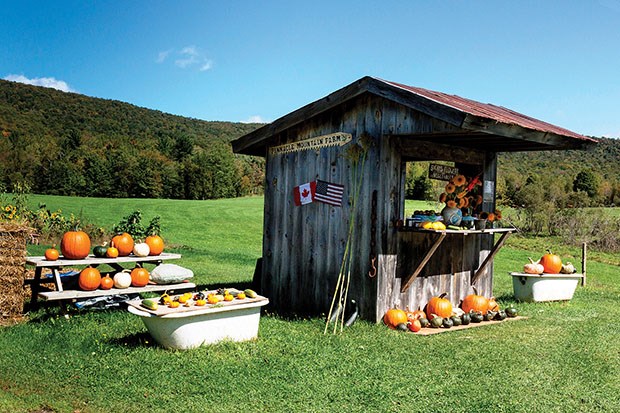I chant, "I'm in Canada. Now I'm in the States," as I step back and forth over the line. Then with one foot on either side, I declare I'm in both.
At the Haskell Free Library and Opera House, which was deliberately built over the international boundary in the early 1900s, I can simultaneously stand in Stanstead, Quebec and Derby Line, Vermont. The building's front door and audience seats are in the U.S. while the circulation desk, books and stage are in Canada.
Gary and I are meandering through the rural areas of the Montérégis and the Eastern Townships southeast of Montreal. Toddling along country roads, appreciating the scenery, finding covered bridges, tasting artisan products and making small town discoveries like border-spanning buildings all enhance our leisurely sojourn from the city.
With the traffic snarls of Montreal left behind, the countryside gently welcomes us. The road undulates over treed hills tinged with the golds, oranges and reds of autumn. Stands of tapped maple trees and pastures dotted with cows alternate with vineyards and apple orchards.
Many territorial struggles amongst the British, French and Americans were fought in this bucolic countryside. A wood blockhouse, dating from 1781, stands in a small Lacolle park. This remnant of the fortifications built by the British to defend against invading American forces is the last remaining structure of its kind in Quebec.
From a short video, we learn a mere 500 men remarkably repelled an attack by more than 4,000 Americans in the spring of 1814. The blockhouse held but the dark walls are scarred with musket ball holes.
We stay in Sutton for a couple of nights. Loyalists established the town in 1799 and French-speaking settlers followed in the mid-1800s. With this heritage, no wonder so many people are effortlessly bilingual.
I start conversations in my rudimentary French but am often answered in English. Our hotel hosts are effusive about their town.
"It's vibrant!" Michel explains as I indulge in the crispest, lightest French toast at breakfast. Afterwards he recommends several scenic stops along the Route de Vins.
The country road is virtually empty of cars as we sedately dawdle along. Cresting a hill, we see Vermont's Green Mountains in the distance. With a wrong turn, we end up at a tiny border crossing. Back on the Route, we find the apple tree-lined drive of Domaine Pinnacle. Some of these trees were planted almost a century ago.
Nearby Frelighsburg has many stone and brick buildings dating from mid-1800 Loyalist times. At the general store, all cozy with warm woods and delicious aromas, we finish lunch with a piece of their famous sugar pie. Mildly maple flavoured, it is akin to a pecan pie without pecans.
Further along the Route, we are tempted by other tastings of "cidre et vin" and one vineyard adds a cultural twist with bizarre sculptures along its paths.
We picnic beside a red, century-old, round barn, one of only nine remaining in Quebec. Round barns, according to folklore, have no corners for the devil to hide in and do his mischief.
We discover several covered bridges from the 1800s before visiting the Saint-Benoit-du-Lac Abbey. Its grey buildings are beautifully situated beside apple orchards on the serene shores of Lake Memphremagog.
North Hatley curves prettily along the top of Lake Massawippi. A flower-lined pier leads to a pagoda overlooking the lake. The water is calm, the late afternoon sun warm. A paddle boarder glides by, a fisherman casts a line and we relish the tranquility.
No wonder tourists from both sides of the border have been attracted to the region since the 1800s.
Travel Writers' Tales is an independent travel article syndicate that offers professionally written travel articles to newspaper editors and publishers. To check out more, visit www.travelwriterstales.com.



